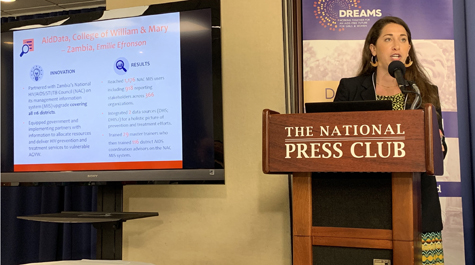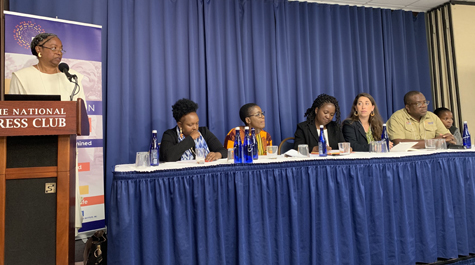Supporting Zambia's campaign against HIV/AIDS
In 2017, 630,000 of the 1.1 million people aged 15 and over living with HIV in Zambia were women. At 5.7 percent, HIV prevalence among young women was more than double that of young men. Zambia’s National HIV/AIDS Council was desperate for a system that would provide information on HIV/AIDS prevention and treatment broken down by age and gender and that could be used to make more informed future decisions.
In 2016, Samantha Custer, Jacob Sims and Alexander Wooley of AidData submitted a grant proposal to the DREAMS Innovation Challenge, a public-private partnership led by the U.S. President’s Emergency Plan for AIDS Relief. The proposal won a two-year, $1.1 million grant for AidData to develop innovative solutions to protect vulnerable young women in sub-Saharan Africa from HIV infection.
“The project plan was to build a tool that would help the National HIV/AIDS Council collect and centralize information on HIV/AIDS activities, but we discovered that there were already dozens of tools people were using, and they lacked data on young women and girls,” Sims said.
In the end, AidData responded to the council’s needs by upgrading their existing paper-based data collection process into an automated, digital one. AidData also improved the council’s online portal so that data could be broken down by age and gender and visualized in interactive dashboards. It was AidData’s first foray, Sims said, into in-country implementation work as opposed to just research.
Emilie Efronson, the AidData program manager for Zambia, was critical to the project’s success. Although she joined the project at the one-year mark, she built a relationship between AidData and Zambia’s National HIV/AIDS Council and shepherded the building of the final tool.
{{youtube:medium|tQBx0KgUrEE Efronson details the project (begins 1:15)}}
“Most of AidData’s work revolves around research seeking new, innovative methods for targeting and evaluating development projects,” Sims said. “This was different. Our DREAMS project responded to a specific need from a country to address a problem that they wanted help solving, and we were able to use AidData’s technical capabilities to do that.”
On May 7, Efronson and Sims traveled to the National Press Club in Washington, D.C., to join representatives from the U.S. Department of State, Office of the U.S. Global AIDS Coordinator and Health Diplomacy, and other youth ambassadors from the DREAMS Innovation Challenge to discuss their results and the lessons they learned.
“We were selected to present as we were one of four projects focusing on ‘applying data to increase impact,’” Efronson said. “From these four projects we were able to demonstrate probably the strongest results of our innovation.”
Efronson told the audience at the Press Club that “with the revamped portal, Zambia’s National HIV/AIDS Council and its partners can now input and access timely data on where and which HIV/AIDS prevention activities have been done across all 116 districts.”
In addition to building the tool, AidData trained 29 council officials on the new system, who went on to train hundreds of district AIDS coordinators and local partners in Zambia. And they’re not done.
Although AidData handed off the tool to the Council at the end of the two-year grant, the organization has asked for AidData representatives to return to the country to explore additional partnership activities.
“We succeeded in our goal, which was to develop a system with Zambia’s National HIV/AIDS Council that would provide those working to end HIV/AIDS with better information for evidence-informed decision-making,” Sims said.
 Skip to main content
Skip to main content


